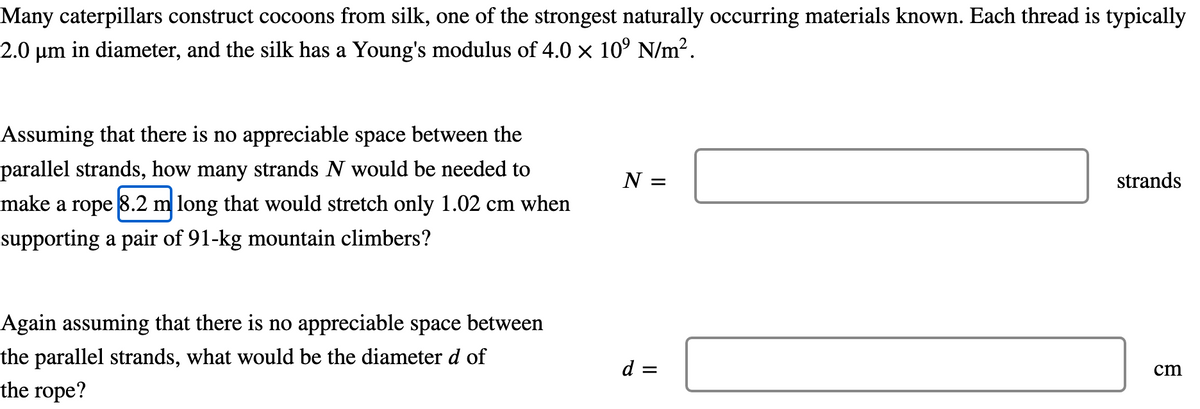Many caterpillars construct cocoons from silk, one of the strongest naturally occurring materials known. Each thread is typically 2.0 µm in diameter, and the silk has a Young's modulus of 4.0 × 10⁹ N/m². Assuming that there is no appreciable space between the parallel strands, how many strands N would be needed to make a rope 8.2 m long that would stretch only 1.02 cm when supporting a pair of 91-kg mountain climbers? N = Again assuming that there is no appreciable space between the parallel strands, what would be the diameter d of the rope? strands d = cm
Many caterpillars construct cocoons from silk, one of the strongest naturally occurring materials known. Each thread is typically 2.0 µm in diameter, and the silk has a Young's modulus of 4.0 × 10⁹ N/m². Assuming that there is no appreciable space between the parallel strands, how many strands N would be needed to make a rope 8.2 m long that would stretch only 1.02 cm when supporting a pair of 91-kg mountain climbers? N = Again assuming that there is no appreciable space between the parallel strands, what would be the diameter d of the rope? strands d = cm
Physics for Scientists and Engineers
10th Edition
ISBN:9781337553278
Author:Raymond A. Serway, John W. Jewett
Publisher:Raymond A. Serway, John W. Jewett
Chapter12: Static Equilibrium And Elasticity
Section: Chapter Questions
Problem 27AP: The lintel of prestressed reinforced concrete in Figure P12.27 is 1.50 m long. The concrete encloses...
Related questions
Question

Transcribed Image Text:Many caterpillars construct cocoons from silk, one of the strongest naturally occurring materials known. Each thread is typically
2.0 µm in diameter, and the silk has a Young's modulus of 4.0 × 10⁹ N/m².
Assuming that there is no appreciable space between the
parallel strands, how many strands N would be needed to
make a rope 8.2 m long that would stretch only 1.02 cm when
supporting a pair of 91-kg mountain climbers?
N =
Again assuming that there is no appreciable space between
the parallel strands, what would be the diameter d of
the rope?
strands
d =
cm
AI-Generated Solution
Unlock instant AI solutions
Tap the button
to generate a solution
Recommended textbooks for you

Physics for Scientists and Engineers
Physics
ISBN:
9781337553278
Author:
Raymond A. Serway, John W. Jewett
Publisher:
Cengage Learning

Physics for Scientists and Engineers with Modern …
Physics
ISBN:
9781337553292
Author:
Raymond A. Serway, John W. Jewett
Publisher:
Cengage Learning

Physics for Scientists and Engineers: Foundations…
Physics
ISBN:
9781133939146
Author:
Katz, Debora M.
Publisher:
Cengage Learning

Physics for Scientists and Engineers
Physics
ISBN:
9781337553278
Author:
Raymond A. Serway, John W. Jewett
Publisher:
Cengage Learning

Physics for Scientists and Engineers with Modern …
Physics
ISBN:
9781337553292
Author:
Raymond A. Serway, John W. Jewett
Publisher:
Cengage Learning

Physics for Scientists and Engineers: Foundations…
Physics
ISBN:
9781133939146
Author:
Katz, Debora M.
Publisher:
Cengage Learning

College Physics
Physics
ISBN:
9781938168000
Author:
Paul Peter Urone, Roger Hinrichs
Publisher:
OpenStax College

University Physics Volume 1
Physics
ISBN:
9781938168277
Author:
William Moebs, Samuel J. Ling, Jeff Sanny
Publisher:
OpenStax - Rice University

Physics for Scientists and Engineers, Technology …
Physics
ISBN:
9781305116399
Author:
Raymond A. Serway, John W. Jewett
Publisher:
Cengage Learning